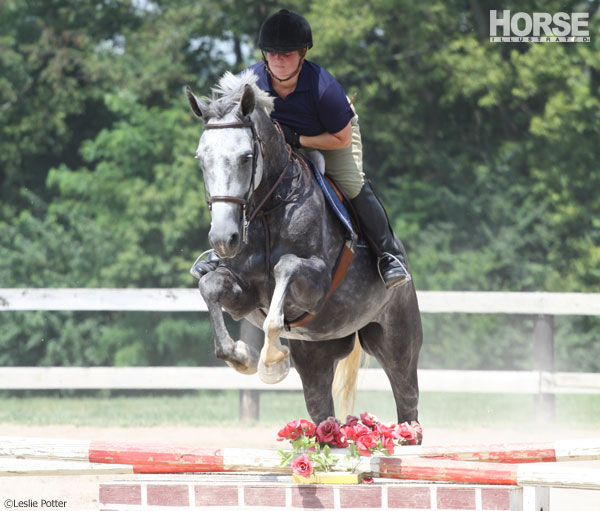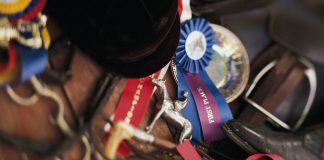Many dedicated hunt seat riders don’t have access to a stadium-sized jumping arena, yet they still want to improve their skills and school their horses. If you’re among this group, here are a few suggestions to make the most of the space you have.

For starters, focus on schooling exercises that encourage your horse to maintain an energetic canter and a long stride. Otherwise the environmental restraints of a small arena will cause your horse to adopt a slow pace and a compressed stride. While a rocking chair canter on a 10-foot stride is comfortable to sit, it won’t win ribbons at a horse show. In competition, courses are set in increments of 12-foot strides. You’ll be forced to jolt your horse into warp drive just to make the correct number of strides in the lines.
Our first exercise serves as a checkpoint to judge if your horse is cantering like a horse or an over-sized pony. In one corner of your arena, arrange three 10- or 12-foot long ground poles in the shape of a fan or semi-circle. (For safety’s sake, allow a few feet of space between the far end of the poles and the arena rail). At the base of the fan, the poles should measure 9-feet apart; at the top of the fan they should measure 12-feet apart.
Your goal is to establish a jumping pace and length of stride, and then maintain it as you approach the fan and canter over the poles. You should feel a definite “bounce, bounce, bounce” as your horse canters over each pole while turning the corner. Yet glance down. Which portion of the fan accommodated your horse’s stride? If your horse’s track was near the base of the fan, then you need to work on extending his stride. When your horse can consistently “bounce, bounce, bounce” over the far end of the fan, you’ll know you’ve achieved a suitable length of stride for hunter competition.
Another reliable exercise is a simple grid that encourages your horse to stretch his stride. Set a crossrail between a pair of standards, with a ground pole at the base on each side. Now add another ground pole on each side, but roll these out about 9-feet from the crossrail. They’ll work as placement poles to regulate your horse’s length of stride. Your job is to maintain a steady trot all the way to the first placement pole. Then, without any urging, your horse should step lightly (not leap) over the placement pole, softly pat the ground with his feet, jump the crossrail, and then hop over the other placement pole. Encourage your horse to canter away from the exercise on a nice long stride before you halt. Eventually raise the crossrail to a small vertical (up to 2’6”), but roll the placement poles out an additional foot to accommodate a bigger jumping effort. This handy exercise can be jumped in both directions.
You can expand this grid to simulate a line of jumps. Reconfigure the elements so a placement pole is set 9-feet in front of a crossrail. Measure 18-feet and set a vertical. As before, trot to the placement pole and allow your horse’s impulsion to carry him over the pole and crossrail. But now, after the crossrail, he’ll take one canter stride and then jump the vertical. When he lands, let him canter several strides, or around the corner, before halting. As you progress, change the vertical into a low oxer. If you raise the oxer over 3-feet, shift those standards back about a foot so that measurement of the grid is opened up to 19 or 20-feet. That will give your horse enough room to stretch his body and make a good jumping effort over the oxer. Always endeavor to practice good jumping, even in a less-than-perfect arena.
Liked this article? Here’s more advice on schooling over fences:
4 Fences 7 Ways
Better Jumping with Ground Pole Exercises
Grid Exercises with Gina Miles






cool
Great tips.
nice tips!